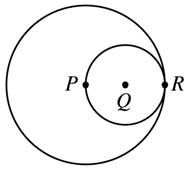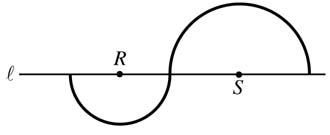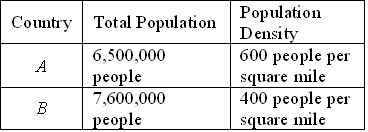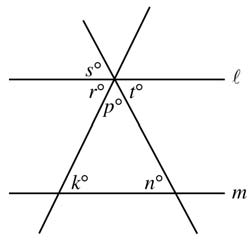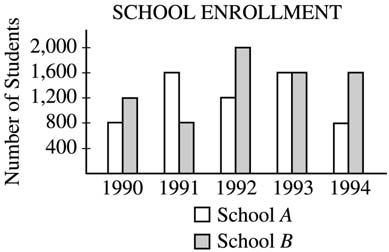SAT Section 7 - Group 2
(22).webp)
In the second group in the seventh section of our SAT quiz series, we look at such mathematical concepts as algebra, quadratic equations, fractions, sequences, angles, ranges, radiuses and more. How many can you get right?
- 1.
If (1/3)y + 9 = 0, then y =
- A.
-27
- B.
-9
- C.
-3
- D.
3
- E.
27
Correct Answer
A. -27Explanation
To solve the equation, we need to isolate the variable y. First, we can subtract 9 from both sides of the equation: (1/3)y = -9. Next, we can multiply both sides of the equation by 3 to get rid of the fraction: y = -27. Therefore, the value of y that satisfies the equation is -27.Rate this question:
-
- 2.
In the figure above, P, Q, and R lie on the same line. P is the center of the larger circle, and Q is the center of the smaller circle. If the radius of the larger circle is 4, what is the radius of the smaller circle?
- A.
1
- B.
2
- C.
4
- D.
8
- E.
16
Correct Answer
B. 2Explanation
Since P, Q, and R lie on the same line, the distance between P and Q is equal to the sum of the radii of the two circles. The radius of the larger circle is given as 4. Therefore, the radius of the smaller circle can be calculated by subtracting the radius of the larger circle from the distance between P and Q. Since the distance between P and Q is 4 (radius of larger circle) + 2 (radius of smaller circle), the radius of the smaller circle is 2.Rate this question:
-
- 3.
Roy planted corn on 1/5 of his land. If he planted 45 acres of corn, how many acres of land does he have?
- A.
90
- B.
112 1/2
- C.
135
- D.
225
- E.
337 1/2
Correct Answer
D. 225Explanation
Roy planted corn on 1/5 of his land, which is equivalent to 45 acres. To find the total number of acres of land, we need to determine the value of 1/5 of the land. We can set up a proportion: 1/5 is to 45 as 1 is to x (total number of acres). Cross-multiplying, we get 5x = 45 * 1, which simplifies to 5x = 45. Dividing both sides by 5, we find that x = 9. Therefore, Roy has 9 times 45 acres of land, which is equal to 225 acres.Rate this question:
-
- 4.
6, 10, 18, 34, 66 The first number in the list above is 6. Which of the following gives a rule for finding each successive number in the list?
- A.
Add 4 to the preceding number.
- B.
Take 1/2 of the preceding number and then add 7 to that result.
- C.
Double the preceding number and then subtract 2 from that result.
- D.
Subtract 2 from the preceding number and then double that result.
- E.
Triple the preceding number and then subtract 8 from that result.
Correct Answer
C. Double the preceding number and then subtract 2 from that result.Explanation
Each number in the list is obtained by doubling the preceding number and then subtracting 2 from that result. This pattern can be observed by multiplying 6 by 2 and subtracting 2 to get 10, then multiplying 10 by 2 and subtracting 2 to get 18, and so on. Therefore, the correct answer is "Double the preceding number and then subtract 2 from that result."Rate this question:
-
- 5.
The two semicircles in the figure above have centers R and S, respectively. If RS = 12, what is the total length of the darkened curve?
- A.
8π
- B.
9π
- C.
12π
- D.
15π
- E.
16π
Correct Answer
C. 12πExplanation
The total length of the darkened curve can be found by adding the circumference of both semicircles. Since the radius of each semicircle is not given, we cannot calculate the exact circumference. However, we know that RS = 12, which means the distance between the centers of the two semicircles is 12 units. This distance is equal to the sum of the two radii. Therefore, each radius is 6 units. The circumference of a semicircle with radius 6 is 2π(6)/2 = 6π. Adding the circumferences of both semicircles gives us a total length of 12π.Rate this question:
-
- 6.
If h and k are positive numbers and h + k = 7, then (7 - k)/h =
- A.
1
- B.
0
- C.
-1
- D.
H
- E.
K - 1
Correct Answer
A. 1Explanation
The expression (7 - k)/h can be simplified by distributing the division to both terms inside the parentheses. This gives us 7/h - k/h. Since h + k = 7, we can substitute k = 7 - h into the expression. This gives us 7/h - (7 - h)/h. Simplifying further, we get 7/h - 7/h + h/h, which simplifies to 1. Therefore, the value of (7 - k)/h is 1.Rate this question:
-
- 7.
The table above shows the populations of two countries and their population densities. The number of square miles in the area of Country B is approximately how much greater than the number of square miles in the area of Country A ?
- A.
200
- B.
3,600
- C.
5,000
- D.
8,000
- E.
950,000,000
Correct Answer
D. 8,000Explanation
The answer is 8,000 because the question is asking for the difference in the number of square miles between the areas of Country B and Country A. The table does not provide the actual number of square miles for each country, so we cannot calculate the exact difference. However, based on the given information, we can infer that the number of square miles in the area of Country B is approximately 8,000 greater than the number of square miles in the area of Country A.Rate this question:
-
- 8.
If x2 = x + 6, which of the following must be true?
- A.
X = 6
- B.
X< 3
- C.
X > 0
- D.
X^2 < x
- E.
X^2 > x
Correct Answer
E. X^2 > xExplanation
If x^2 = x + 6, then it implies that x^2 is greater than x since the value of x^2 is increased by 6 compared to x. Therefore, the statement x^2 > x must be true.Rate this question:
-
- 9.
Let the functions f be defined by f(x) = 5x - 2a, where a is a constant. If f(10) + f(5) = 55, what is the value of a?
- A.
-5
- B.
0
- C.
5
- D.
10
- E.
20
Correct Answer
C. 5Explanation
The given functions f(x) = 5x - 2a is used to calculate the values of f(10) and f(5). By substituting x = 10 into the function, we get f(10) = 5(10) - 2a = 50 - 2a. Similarly, by substituting x = 5 into the function, we get f(5) = 5(5) - 2a = 25 - 2a. The sum of f(10) and f(5) is 50 - 2a + 25 - 2a = 75 - 4a. Since the sum is given to be 55, we can set up the equation 75 - 4a = 55 and solve for a. Simplifying the equation gives 20 = 4a, and dividing both sides by 4 gives a = 5.Rate this question:
-
- 10.
A number is called “even-odd” if it is halfway between an even integer and an odd integer. If x is an even-odd number, which of the following must be true? I. 2x is an integer. II. 2x is even-odd. III. x is halfway between two even integers.
- A.
I only
- B.
II only
- C.
I and II only
- D.
II and III only
- E.
I, II, and III
Correct Answer
A. I onlyExplanation
If x is an even-odd number, it means that x is halfway between an even integer and an odd integer. This means that x is not an integer itself. Therefore, when we multiply x by 2 to get 2x, it will always result in an integer because multiplying any non-integer by 2 will always give an integer. This means that statement I is true. However, statement II is not necessarily true because 2x may not be halfway between an even integer and an odd integer. Similarly, statement III is not necessarily true because x may not be halfway between two even integers. Therefore, the only statement that must be true is statement I.Rate this question:
-
- 11.
If m is a positive integer, which of the following is NOT equal to (24)m ?
- A.
2^(4m)
- B.
4^(2m)
- C.
2^m(2^(3m))
- D.
4^m(2^m)
- E.
16^m
Correct Answer
D. 4^m(2^m)Explanation
The expression (24)m can be simplified as 2^(4m), which means raising 2 to the power of 4m. Looking at the options, 4^m(2^m) is not equal to 2^(4m) because it is the product of two different terms raised to the power of m, whereas 2^(4m) is a single term raised to the power of 4m. Therefore, 4^m(2^m) is not equal to (24)m.Rate this question:
-
- 12.
In the figure above, l || m. Which of the following must equal 180?
- A.
K + n + r
- B.
K + p + s
- C.
N + p + s
- D.
P + n + t
- E.
R + s + t
Correct Answer
B. K + p + sExplanation
If l is parallel to m, then the alternate interior angles formed by the transversal line t are congruent. This means that angle k is congruent to angle p, and angle s is congruent to angle p. Therefore, the sum of angles k, p, and s must equal 180 degrees.Rate this question:
-
- 13.
How many different ordered pairs (x, y) are there such that x is an even integer, where 4 ≤ x ≤ 10, and y is an integer, where 4 < y < 10 ?
- A.
8
- B.
12
- C.
20
- D.
30
- E.
36
Correct Answer
C. 20Explanation
There are 7 even integers between 4 and 10 (4, 6, 8, 10). There are 5 integers between 4 and 10 (5, 6, 7, 8, 9). The number of different ordered pairs (x, y) can be calculated by multiplying the number of even integers by the number of integers, which is 7 * 5 = 35. However, the question specifies that y should be greater than 4 and less than 10, so we need to subtract the pairs where y is equal to 4 or 10. There are 2 such pairs (8, 4) and (8, 10). Therefore, the correct answer is 35 - 2 = 33.Rate this question:
-
- 14.
N(t) = 500(0.81)t The function above can be used to model the population of a certain endangered species of animal. If n(t) gives the number of the species living t decades after the year 1900, which of the following is true about the population of the species from 1900 to 1920 ?
- A.
It increased by about 1,000.
- B.
It increased by about 320.
- C.
It decreased by about 180.
- D.
It decreased by about 320.
- E.
It decreased by about 1,000.
Correct Answer
C. It decreased by about 180.Explanation
The given function represents the population of the species as a function of time, where t represents the number of decades after the year 1900. Since the function is of the form n(t) = 500(0.81)t, it is an exponential decay function. This means that as time increases, the population decreases. Therefore, from 1900 to 1920 (which is a span of 2 decades), the population of the species would have decreased. The exact amount of decrease can be calculated by substituting t = 2 into the function: n(2) = 500(0.81)2 = 500(0.6561) ≈ 328.05. Therefore, the population decreased by about 180 from 1900 to 1920.Rate this question:
-
- 15.
A sphere of radius r inside a cube touches each one of the six sides of the cube. What is the volume of the cube, in terms of r ?
- A.
R^3
- B.
2r^3
- C.
4r^3
- D.
(4/3)r^3
- E.
8r^3
Correct Answer
E. 8r^3Explanation
The cube has an edge length equal to twice the radius of the sphere. Since the radius of the sphere is r, the edge length of the cube is 2r. The volume of a cube is calculated by cubing its edge length, so the volume of the cube is (2r)^3 = 8r^3.Rate this question:
-
- 16.
According to the graph above, in which year was the ratio of the number of students enrolled at School B to the number of students enrolled at School A the greatest?
- A.
1990
- B.
1991
- C.
1992
- D.
1993
- E.
1994
Correct Answer
E. 1994 -
Quiz Review Timeline +
Our quizzes are rigorously reviewed, monitored and continuously updated by our expert board to maintain accuracy, relevance, and timeliness.
-
Current Version
-
Jun 12, 2023Quiz Edited by
ProProfs Editorial Team -
Jun 12, 2011Quiz Created by
Mmmaxwell



